April 9, 2010
Air Date: April 9, 2010
FULL SHOW
SEGMENTS
A History of Safety and Environmental Violations
View the page for this story
The explosion at the Upper Big Branch coal mine in West Virginia may have been preventable. Massey Energy, the mine’s owner, has a long history of safety and environmental violations. Michael Shnayerson wrote a book “Coal River” about the powerful coal company. He tells host Jeff Young about Massey’s history and its CEO Don Blankenship. (12:00)
Cool Fix for a Hot Planet
/ Emily GuerinView the page for this story
Cutting prison energy costs and greenhouse gas emissions is a breeze with wind power. Living on Earth's Emily Guerin reports. (01:55)
Cash for Climate
View the page for this story
Democratic Senator Maria Cantwell of Washington has a plan for limiting greenhouse gas emissions and reforming our energy sector. Senator Cantwell and Republican Senator Susan Collins of Maine are pushing for the CLEAR Act that calls for a cap and dividend method. This approach makes polluters pay for their emissions and gives the revenues to consumers. Senator Cantwell tells host Jeff Young and why she thinks a cap and dividend system is superior to cap and trade. (05:25)
The Politics of Capping Emissions
View the page for this story
The Obama administration recently made two decisions to reduce our dependence on foreign oil - expanding offshore oil drilling and tightening the fuel efficiency standards of cars. But taking action on climate change by capping our greenhouse gas emissions is still a big political challenge. Economist Robert Stavins talks with host Jeff Young about the administration's energy goals and about two bills in Congress that promise to slow climate change without slowing the economy. (05:00)
Bird Eggs Unhatched
/ Laurie SandersView the page for this story
In the 1800’s, a man named Harry Curtiss Mills started a collection. The Connecticut resident amassed and traded thousands of bird eggs, representing 840 species. His egg collection was donated to a local library where for decades it was neglected, stored away in a cabinet. Now, Harry Curtiss Mill’s eggs have found a new home in the University of Connecticut’s Biodiversity Research Collections. As producer Laurie Sanders reports, the egg collection provides a unique record of bird life in 19th century Connecticut. (05:40)
Poetry Please!
View the page for this story
In honor of National Poetry Month, Living on Earth presents the work of some of our nation’s outstanding poets. This week, we’ll hear from 2007 Pulitzer Prize winner, Natasha Trethewey, professor of English at Emory University. She reads her poem “Monument” and talks about what inspires her to write verse. (03:20)
Comic Relief for Climate Change
View the page for this story
Melting glaciers and sea-level rise are no laughing matter, but author Ian McEwan finds plenty of humor in the global effort to tackle climate change. Host Jeff Young speaks with McEwan about his new novel "Solar", in which human nature is the biggest obstacle to saving the planet. (09:30)
Woodcock Courtship
View the page for this story
They’re short, stout, and reclusive. But when it comes to attracting a mate, the male American woodcock pulls out all the stops. Bob Speare, a naturalist with the Massachusetts Audubon Society, takes us to the woodcock’s singing grounds in Ipswich, Massachusetts to watch its unusual mating ritual. (03:00)
Show Credits and Funders
Show Transcript
HOST: Jeff Young
GUESTS: Michael Shnayerson, Carol Raulston, Maria Cantwell, Robert Stavins, Ian McEwan
REPORTER: Laurie Sanders
COOL FIX: Emily Guerin
POEM: Natasha Tretheway
[THEME]
YOUNG: From Public Radio International - this is Living on Earth.
[THEME]
YOUNG: I’m Jeff Young. A mining disaster puts the spotlight on one of the coal industry’s worst offenders - Massey Energy.
SCHNAYERSON: This is a company that acts as if rules are just there to be ignored. Its environmental record is truly, I think, unique in its terribleness. It therefore racks up more violations than any other coal company on an order of magnitude.
YOUNG: Also – novelist Ian McEwan takes on climate change – with a comic twist -
MCEWAN: Climate change is not a very friendly subject matter for the novel. It’s made me feel that I ought to reflect something of the farce of our efforts so far, and the huge gap that exists between our declarations of what we want to do and what we end up actually doing.
YOUNG: These stories and a natural celebration of poetry month this week on Living on Earth. Stick Around!
ANNOUNCER: Support for Living on Earth comes from the National Science Foundation, and Stonyfield Farm.
A History of Safety and Environmental Violations
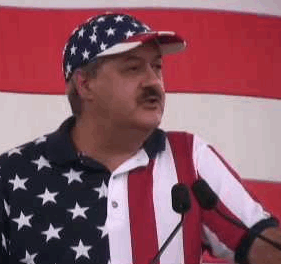
Massey Energy CEO Don Blankensip talking to the crowd at a Labor Day picnic he hosted.
YOUNG: From the Jennifer and Ted Stanley Studios in Somerville, Massachusetts—this is Living on Earth. I’m Jeff Young. It’s the worst mining disaster in the U.S. in decades. As we record this program at least 25 miners are dead—killed in a massive explosion in the heart of West Virginia’s coal country. Officials and families are left with questions and grief.
MANCHIN: Rails, train rails that go back in? Look like they’ve been twisted like a pretzel. That’s horrific. That’s an explosion that—it’s just beyond proportion.
DAVIS: I kind of turned around and walked away from him, he’s like, ‘What, Dad?’ I said, ‘I love you, buddy’. He said, ‘I love you, too, Old Man. Now I’m gonna go cut me some coal.’ That’s my last words I heard from him.
YOUNG: We heard West Virginia Governor Joe Manchin and miner Tommy Davis, whose son, Cory was killed. Mr. Davis also lost his brother and nephew in the explosion. Mine safety investigators are still searching for an exact cause.
They’re also reviewing the safety record at the Upper Big Branch mine, which amassed more than 1,100 violations in the past three years, many of them serious. Federal regulators even ordered parts of the mine closed 60 times over the past year. The mine is just south of Charleston, the state capital, in the Coal River Valley. And all along the Valley are the scars coal mining has left on lives and the landscape.
[SOUNDS OF TRAINS AT CROSSING]
YOUNG: Follow Route 3 and the railroad tracks a few miles south from the disaster scene and you’ll find Marsh Fork Elementary. The school has been the staging center for media briefings since the explosion. Just uphill, another coal mine looms over the school. This one a massive mountaintop removal operation. Residents like Ed Wiley fear that mine and its lake of semi-liquid coal waste endangers school kids.
WILEY: And when you've got two point eight billion gallons of toxic sludge sitting over an elementary school, it's not good.
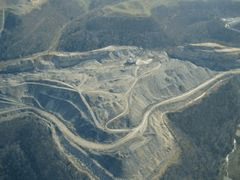
A mountain top removal mine in West Virginia (Photo: Jeff Young)
YOUNG: Just over the mountain to the west, Lora Webb watches the tiny community of Twilight disappear, as a coal company buys up houses and blasts away the mountains.
WEBB: I think if king coal has his way about it, I think that it'll be gone, it won't exist anymore. You know, what kind of treatment is that to the citizens of a community that's supplying the rest of America with power?
YOUNG: In neighboring Logan County, family members still grieve the deaths of two men lost in a mine fire in 2006. And just across the state line in eastern Kentucky, residents remember the massive spill of coal slurry ten years ago that destroyed streams nearly ten years ago.
All these incidents have one thing in common: Massey Energy. Massey is the country’s fourth largest coal producer, and has racked up record fines for safety and environmental violations. Writer and journalist Michael Shnayerson spent nearly three years reporting on Massey for his book, “Coal River”. Michael Shnayerson, welcome to Living on Earth.
SHNAYERSON: Hi, Jeff, nice to be here.
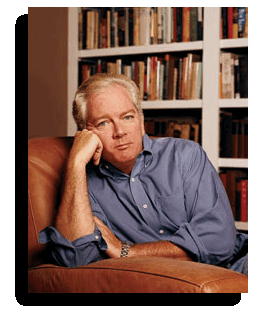
Michael Shnayerson is author of “Coal River” (Courtesy of Michael Shnayerson)
YOUNG: Now, part of your reporting for the book dealt with this very mine where the explosion took place—the Upper Big Branch mine, is that right?
SHNAYERSON: It did, yeah. The story of Upper Big Branch is in a sense a story of Massey in microcosm. It was a union operation, as really all the mines were in the coal fields at one time, but soon after Massey got a hold of it in the early ‘90s, Don Blankenship—the Chairman and CEO of Massey—made it his personal campaign to break the union at the mine. And so even though most of the miners were union miners, and you would think that in an election they would all vote for the union, Don began a personal campaign.
He would fly in on his helicopter to Upper Big Branch, he would take all the union miners to Dollywood, and those who seemed to be on the fence in their voting—new cars would mysteriously appear in their driveways. And, low and behold, he won the vote in 1997. And soon after that bonuses were cut, miners found themselves working longer hours, they had been working eight-hour shifts, now they work 12-hour shifts because that way the mine, which operated 24 hours a day only had two shifts—so only two shifts’ worth of health insurance, and fatalities occurred.
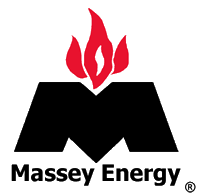
The Massey Energy Logo (Courtesy of the Library of Virginia)
YOUNG: In 2006 there was a fire at another Massey subsidiary mine called Aracoma nearby in Logan county. Two men were killed there and in the criminal investigation that followed we learned about a memo that Mr. Blankenship wrote, and it reads: “If any of you have been asked by your group president, supervisors, engineers, or anyone else to do anything other than run coal, you need to ignore them and run coal.”
SHNAYERSON: Well, in fairness, Don later disavowed that memo and said that safety was a top priority at Massey. But, you know, in the end the events and the facts speak for themselves. That particular disaster at Aracoma came after some 90 safety violations mostly for the problems that went on to cause the fire.
This tragedy that just occurred at Upper Big Branch seemed to have been the result of a methane explosion—well, all you can do to try to avoid the danger of a static explosion of methane is to ventilate the underground mine extremely well with huge fans and other things. It’s not hard to do, but the fact that this explosion appears to have come from it indicates, as do all the violations that Massey racked up in the last years, a real recklessness in regard to the measures that do need to be taken.
YOUNG: Let’s talk a bit about Mr. Blankenship, Massey’s CEO. Last year, he and his company sponsored a big Labor Day picnic where he had stars of country and rock music, and drew tens of thousands of people, and he gave a speech there railing against Washington regulation and climate change legislation.

Massey Energy CEO Don Blankensip talking to the crowd at a Labor Day picnic he hosted.
BLANKENSHIP CLIP: As someone who has overseen the mining of more coal than anyone else in the history of central Appalachia, I know that the safety and health of coal miners is my most important job. I don’t need Washington politicians to tell me that, and neither do you.
[CROWD CHEERING]
BLANKENSHIP CLIP: But, I also know—I also know that Washington and state politicians have no idea how to improve miner safety. The very idea that they care more about coal miner safety than we do is as silly as global warming.
SHNAYERSON: You know, for a storyteller, Don Blankenship is in a way a gift because he’s a storybook villain. And the thing is he doesn’t—one thing you have to say with sort of grudging respect is that Don doesn’t hide his true colors.
He is an avowed sort of Darwinian capitalist, and he feels that he needs to do as the head of Massey whatever is necessary to produce profits. And if safety measures get in the way, he’s going to tell his managers to, if not ignore them, to make them a second priority. And he’s taken a certain—I would say—glee in basking in his notoriety as the most aggressive coal baron and, in particular, the most aggressive mountaintop removal operator.
YOUNG: So, tell me what you learned about Massey’s record when it comes to environmental performance?
SHNAYERSON: To Massey the environment seems to be just an impediment to either be blasted away or, you know, ignored as it does its underground mining. Massey routinely racks up far, far more violations than any other coal companies in the region—and there are some large companies in the region, like Peabody or Consol. Massey just doesn’t seem to care about the environment, frankly.
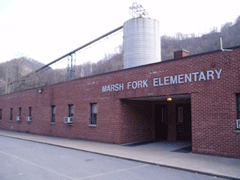
A Massey energy company coal silo looms over Marsh Fork Elementary. (Photo: Jeff Young)
YOUNG: And you reported on, as we have, this elementary school, Marsh Fork Elementary, which is literally in the shadow of a Massey coal operation.
SHNAYERSON: That’s right—one of Massey’s many subsidiaries, Goals Coal, actually operates right above a little public elementary school; it’s been there for decades. In recent years, what Massey has done is to drastically ramp up its mountaintop removal operations there, which necessitates creating an impoundment for all the liquid, sludgy waste, which creates this sort of ever-expanding mountain lake, if you will.
And if that lake happens to bust through its earthen barrier, it can just roll down a hillside and there’s a distinct danger—has been—that the 240 children of the Marsh Fork Elementary school could be drowned.
YOUNG: And we should mention that a failure of an impoundment like this one did occur at another Massey mine in eastern Kentucky and released something that was like 30 times what was released in the spill of the Exxon Valdez.
SHNAYERSON: Yes, indeed. In October of 2000 a Massey impoundment in Martin County, Kentucky did burst through its earthen barrier and a 300-million gallon spill of toxic sludge resulted. A little known fact is that the slurry spill in Martin County was actually the worst environmental disaster in the United States east of the Mississippi.
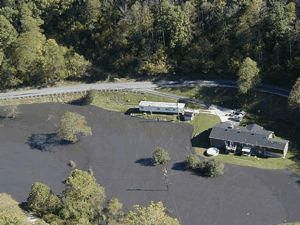
Coal Slurry escapes out of an earthen embankment near the Martin County Mine in Kentucky. (Courtesy of Archives Kentucky)
YOUNG: Do you think that Mr. Blankenship, and Massey Energy, has reached a turning point with the disaster at the Upper Big Branch Mine?
SHNAYERSON: Well, I think it’s unfortunately a little Polly-Annish to feel that a tragedy like this will change the way mining’s practiced. However, specific legislation always comes out of a truly large disaster like this. You know, one has to think that at least the tide of public opinion has turned against Massey long enough that they may be more careful for a while.
YOUNG: Michael Shnayerson, his book is “Coal River”. Thank you.
SHNAYERSON: Thank you, Jeff.
YOUNG: Massey Energy did not respond to our request for comment. We did reach the industry group that represents Massey and other coal companies, the National Mining Association. Carol Raulston is a spokesperson for the NMA.
RAULSTON: Massey has put a lot of effort and energy into improving its safety record over the last three to four years. In fact, last year they had three of the safest operations in all of American mining. So, they certainly have done an exemplary job in some operations. This operation may not meet those standards that they’d even set for themselves.
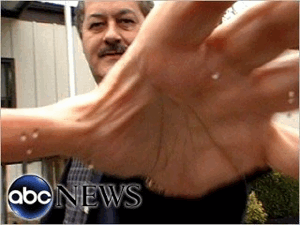
Massey Energy CEO Don Blakenship told an ABC News reporter “If you're going to start taking pictures of me, you're liable to get shot," just before grabbing the reporters camera.
YOUNG: Looking at the past record of this mine and of Massey’s mines, in general, it doesn’t look like a very good record and I’m wondering what responsibility your organization feels to make member companies like Massey improve their safety record.
RAULSTON: We have a constant safety awareness program that we’re involved in to continue to work with our members to improve their safety performance. It is our top priority at NMA.
YOUNG: Massey, of course, is also the company that in 2000 was responsible for a slurry spill. Massey’s a company that in 2007 the Environmental Protection Agency said it violated the Clean Water Act more than 4,000 times. At what point do you have to say to Massey Energy, ‘Clean up your act’?
RAULSTON: We believe it is the responsibility of every mining company to abide by the law and our members understand that. But I think right now—
YOUNG: But they’re clearly not!
RAULSTON: The focus right now is on supporting the family.
YOUNG: What are you doing to try to support the people in West Virginia?
RAULSTON: Obviously, we’ve been praying for them, we’re in contact with a number of them, and we’ve assisted with member companies who have sent more than 20 rescue teams there and a tremendous amount of equipment to assist in this second phase of the effort.
YOUNG: That’s Carol Raulston with the National Mining Association. There’s much more about Massey Energy and mine safety at our website, l-o-e dot org.
Related links:
- Click here to hear a longer interview with Michael Shnayerson
- Massey Energy Home Page
- Michael Shnayerson’s Home Page
- LOE story on the Massey mine near Marsh Fork Elementary
- LOE Story: EPA Eyes Mountaintop Removal Mining
- LOE Story: Lost Mountain
- LOE Story: Hold on Coal
- LOE Story: Calculating Coal's Toll
- LOE Story: Scientists Push Against EPA Decision
- Mine Safety and Health Administion
- Mine Disasters Data
- LOE interviews mine inspector who tried to find the truth about Massey’s KY slurry spill
[MUSIC: The Sound Styalistics “Night Theme” from Play Deep Funk (Freestyle Records 2007)]
YOUNG: Just ahead—Senator Maria Cantwell and her clear alternative to cap and trade—keep listening to Living on Earth.
Cool Fix for a Hot Planet
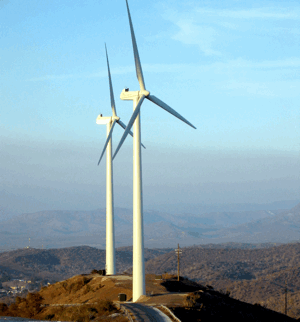
Built in honor of Earth Day in 2005, the four wind turbines at the Guantanamo Bay navy base cut annual energy costs and carbon emissions by $1.2 million dollars and 13 million pounds, respectively. (Photo: Kathleen T Rhem, US Navy)
YOUNG: It’s Living on Earth, I’m Jeff Young. Just ahead—natural history takes flight with an antique egg collection—but first this Cool Fix for a Hot Planet from Emily Guerin.
[COOL FIX THEME]
GUERIN: It takes a lot of energy to keep a prison running 24-seven. Annual electricity bills in the millions have government officials looking for ways to cut costs. Now some are turning to wind as a solution.
Prisons are often sited in remote locations. Those windy islands or hilltops are well suited for turbines, avoiding the “Not in My Backyard!” opposition that bogs down other wind projects.
In 2005, the federal prison in Victorville, California became the country’s first to use wind energy. A single turbine provides all the electricity for one of the sites’ four prison complexes, and 15 percent for another. Now, Texas, Virginia and Massachusetts are considering powering their jails with wind, and selling excess electricity back to the grid.
The Navy also began to harness the wind five years ago at Guantanamo Bay in Cuba. Before installing four turbines, Guantanamo spent more than 30,000 dollars a day on diesel fuel to run generators. Today the wind farm provides up to 12 percent of the base’s electricity. It seems that at a military base or a prison, the answer to reducing energy bills could be blowing in the wind.
That’s this week’s Cool Fix for a Hot Planet. I’m Emily Guerin.
YOUNG: And if you have a Cool Fix for a Hot Planet, we'd like to know it. If we use your idea on the air, we'll send you a sleek electric blue Living on Earth tire gauge. Call our listener line at 800-218-9988, that's 800-218-99-88. Or email coolfix—that's one word—at l-o-e dot org.
[END COOL FIX THEME]
Cash for Climate

Senator Maria Cantwell (D-WA) Credit: Wikipedia
YOUNG: When the U.S. Senate returns to business in a few days a bipartisan trifecta of senators will be trying to hammer out a compromise bill on climate change. Senators John Kerry, Lindsay Graham and Joe Lieberman propose a carbon cap on the electricity sector and some sort of carbon fee on oil. The details are murky, but there’s a clear alternative offered by another senator.
Senator Maria Cantwell, a democrat from Washington, has partnered with republican Susan Collins of Maine for what they call the CLEAR act. It proposes a cap and dividend alternative to cap and trade—auctioning off all the carbon emissions permits and returning most of the money to consumers. Senator Cantwell is with us now to discuss her bill. Welcome to Living on Earth!
CANTWELL: Thank you very much.
YOUNG: What is the CLEAR act, and why do you think your approach is better than what Senators Kerry and Graham are trying to do?
CANTWELL: We need predictability for the future; we need people to plan to get off carbon, but to do so in a way that it’s clear that we’re going to make the reduction, but with the least impact to the economy. We propose doing that with a simple auction and an energy rebate back to consumers.
YOUNG: Senator, you’ve been a very vocal critic of many abuses of energy trading, and I think a very insightful critic, and played an important watchdog role—
CANTWELL: Thank you for that, thank you for noticing.
YOUNG: What are your concerns about a carbon trading system, carbon market?
CANTWELL: Well, we know that there was a report in Copenhagen that 95 percent of the European market could have been subject to manipulation. We know that our U.S. economy is still reeling from the lack of oversight and transparency in our housing markets and things like derivatives that are still kind of operating in very dark markets without the kind of transparency that’s necessary.
We don’t need to repeat that with carbon. What that does is it just drives volatility and the one thing we know, if we’re going to make this transition off of carbon onto cleaner sources, we don’t want volatility in the mean time. We want that to be a transition that is smooth as possible, and trading really will lead to that level of volatility.
YOUNG: Do you think we run the risk of a sort of carbon bubble?
CANTWELL: Well, we know that there were carbon futures in Europe being cut up in tranches and sold similar to credit default swaps. That means the true value and the ability to pay on that value was being hidden.

Caption: Senator Maria Cantwell (D-WA)(Courtesy of Wikipedia)
And I think that it’s hard for the U.S. Congress right now to stop the current manipulation that’s happening in these dark markets on these toxic assets, and that’s the overall market, so we’ll see what happens with regulatory reform whether we’re able to accomplish that. But I think starting a new market when you don’t need that level of volatility—in fact, you’re really trying to discourage it—would be the wrong way to go.
YOUNG: As I understand it Senators Kerry, Graham and Lieberman are—they’re essentially in what you might call the horse trading stage of things and trying to craft some sort of compromise that involves more off-shore drilling, more subsidies to nuclear and coal industries in order to get people to buy into the process. What do you think of that approach and wouldn’t you have to do the same sort of thing to overcome the vested interests here?
CANTWELL: We’re trying to get a legislative solution that the American people can buy into, that they can see that this is a workable way for us to get off of carbon; and to my more skeptical colleagues, a process that you literally are going to put into legislative statute, that you know how the formula works and how the reductions will be made. So you’re not worried about this changing.
The predictability is in the simplicity of the formula. And I think that while there probably will be discussions on how to add the larger energy pieces to this, what we’re really trying to do is unveil a concept and push an idea that is the level of simplicity that is needed to get America’s buyoff. It is a clear and predictable path.
YOUNG: You’re on the energy committee of the Senate, you have a good feel for the complicated politics here—what do you think, what are the chances that we will see a meaningful climate bill in this election year?
CANTWELL: I don’t know what day or month we’ll have a solution to this, but I know this: that we are going to see rising energy costs again this summer. That could be over 100 dollars a barrel, I’m sure that in the not-to-distant future it will go well over 100 dollars a barrel.
And I think that EPA will ultimately want to make a decision and move forward here. And I think those two factors will drive my colleagues to look for a solution like the CLEAR act that is a more predictable path.
YOUNG: Senator Maria Cantwell of Washington, thank you very much.
CANTWELL: Thank you.
Related links:
- Click here to learn more about Senators Cantwell and Collins’ bill, the CLEAR Act.
- For more on the CLEAR Act click here.
- Check out the World Resources Institute's analysis of Senator Cantwell's bill.
The Politics of Capping Emissions
YOUNG: Those Senate negotiations are also being shaped by dramatic announcements by president Obama. In just two days, he took two steps that could transform the energy landscape. Opening up parts of the U.S. coast to offshore drilling and setting strict, new emissions standards on vehicles.
Robert Stavins is with us now for some analysis of how the energy and climate proposals might all fit together. He’s an environmental economist with Harvard University’s John F. Kennedy School of Government. And professor Stavins, let’s start with your assessment of the ideas we just heard from Senator Cantwell.
STAVINS: So a cap and dividend approach is actually a cap and trade approach by a different name. It is a cap and trade mechanism which uses a specific allocation of the allowances that is 100 percent auction, and then uses a specific use of the revenue, which is 75 percent of that revenue going directly back to households in the form not just of checks once a year, but from a political perspective—quite cleverly—every month, presumably with your congressman’s and senator’s return address and name on the envelope.
[YOUNG LAUGHS]
STAVINS: That is the essence of it; it is what I would call a populist approach. And it appeals to what is fundamentally we’re seeing now—a resurgence of populism in the United States, I think, from both the left and the right. It appeals to the populism from the left because it’s 100 percent auction, so we’re going to hurt those bad corporations; it appeals to the populism of the right because it looks like a tax cut, we’re going to send everybody a check in the mail.
YOUNG: Do you think that that broad appeal—if people look at that and say, ‘Wait a minute, you’re going to put money in my pocket, hey, I’m on board.’ Would that provide the political momentum to overcome the strong entrenched interest that the proponents of action on climate change have to deal with to overcome big oil, big coal, etc.?
STAVINS: Well, it would be difficult because it makes—as soon as it’s 100 percent auctioned that means that companies are paying not only their compliance costs, they’re paying for the right to emit. That’s what they’re buying those allowances for.
So it definitely increases the cost to the regulated sectors, so that’s why the question is, Is that populist politics ultimately more successful at establishing a constituency for action than the conventional, regional and sectoral politics of the cap and trade system used in the House of Representatives? I don’t know what the answer to that is. If it turns out the politics of this approach is better then I would be an enthusiast of this legislation if they just fixed one or two things.
YOUNG: So, what are the problems you see with Senator Cantwell’s approach?
STAVINS: So, the problem with this approach is that it is essentially cap and trade without the trade. Now there is some trade involved, but it is highly restricted. I think that the reason that they’ve done that was because they’re very concerned about the use of markets. As a result of the recession, the continuing high rates of unemployment, and the fact that the recession was at least partially due to some market manipulation.
Now, observing those problems with markets and then saying we’re not going to allow markets is in my opinion roughly equivalent to the head of the Federal Aviation Administration observing a plane crash and therefore banning flying.
YOUNG: Let’s talk a bit about senators Kerry, Graham and Lieberman working on some sort of bipartisan, you might call it tri-partisan, bill. Does the president’s action on offshore drilling help those senators get closer to crafting a compromise?
STAVINS: Well, this is an interesting question. I mean frankly it confuses me somewhat. Those three senators are trying very hard to put together a bipartisan piece of legislation; they’re including within it some very meaningful movements on CO2 emissions reductions through cap and trade and other mechanisms on various sectors.
And one of the ways they’re building political support is also to put in attention to nuclear power and to offshore, and for that matter onshore, oil exploration and development. This has the appearance, anyway, of the president having stepped outside of that process, the White House, and having announced what was one of the bargaining chips sort of already giving it away as opposed to holding it back. So it does surprise me.
YOUNG: Several of the people involved in this process keep saying, cap and trade is dead. Senator Graham of South Carolina says, ‘Cap and trade is dead!’ And yet, the proposal they’re working on, what little we know of it so far, looks a lot to me like cap and trade. Is cap and trade dead, or has it just assumed another form here?
STAVINS: I don’t think it’s dead at all. I think it’s been a very successful policy several times in U.S. history that’s how we phased the leaded gasoline out of the market faster than anyone thought and saved about 250 million dollars per year, a lot of it passed onto consumers in terms of lower gasoline prices. It’s also how we’ve cut sulfur dioxide emissions as a precursor of acid rain.
And ironically, the U.S. having been the party that got the cap and trade provision into the Kyoto Protocol, now we’ve backed off, at least politically it seems to some degree in the U.S., the European Union’s gone ahead, Australia’s using this approach, New Zealand is, Japan—where I was just a week and a half ago—has reversed themselves, they’re going forward with cap and trade. So all of them are turning behind and looking and saying, ‘Wait, you were leading us, United States, where are you now?’
YOUNG: Professor, thanks very much.
STAVINS: My pleasure.
YOUNG: Harvard environmental economist Robert Stavins. There’s much more about the emerging energy and climate bills at our website, l-o-e dot org.
Related links:
- For more on environmental policies, check out Robert Stavins’ blog.
- For more on the CLEAR Act click here.
- Check out the World Resources Institute's analysis of Senator Cantwell's bill.
[MUSIC: Bill Laswell & Roots Tonic “Clean Escape” (the Crew Is All here) from Bill Laswell Meets Roots Tonic (ROIR/Virtual 2006)]
Bird Eggs Unhatched
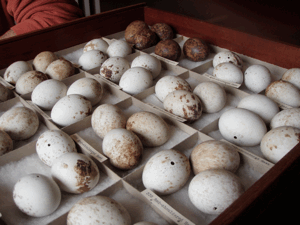
(Photo courtesy of UConn)
YOUNG: When Farmington, Connecticut’s Barney Library undertook a major renovation last year, staff decided to get rid of some very fragile stuff. 8,000 bird eggs. The egg collection was donated in 1924, and has been stored in a closed cabinet on the library’s second floor ever since. The Library donated the egg collection to the University of Connecticut’s Biodiversity Research Collections. Producer Laurie Sanders was there on moving day and has our story.
WOMAN: Hey Tanner, don’t forget to dig out the batting from underneath the box, OK?
SANDERS: It’s 9 in the morning, and a small group of grad students and faculty from UCONN has just arrived at the Barney Library in Farmington, Connecticut.
[SOUNDS OF SOMEONE CLIMBING METAL STAIRCASE]
SANDERS: The crew uses a back staircase to reach a second floor meeting room. It’s here inside a special wooden cabinet that an enormous collection of wild bird eggs has sat for decades.
RUBEGA: It’s a beautiful piece of furniture, but it’s really not secure storage from the point of view of modern specimen storage.
SANDERS: Margaret Rubega is Connecticut’s State Ornithologist, and a biologist at UCONN.
RUBEGA: It’s truly stunning the condition this collection is in. It really has survived through benign neglect and the protection of being in an institution like a library.
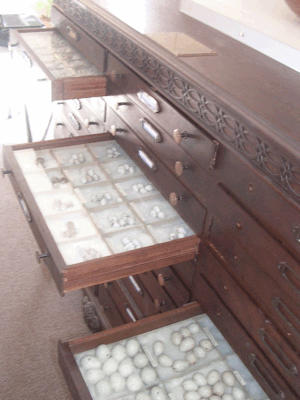
The Barney Library in Farmington, Connecticut housed this bird egg collection for more than 80 years. They recently donated it to the University of Connecticut’s Museum of Natural History. (Photo courtesy of UConn)
SANDERS: Egg collecting was a wildly popular hobby in the 19th century. But Rubega says this collection is extraordinary.
RUBEGA: It’s a big collection. It’s fully documented, and especially what’s important for us as an institution of the state, is that the vast majority of eggs in this collection come from Connecticut. It’s a physical library of the birds who were in Connecticut in the 19th century. The habitat has changed, the bird life has changed, the conditions under which the birds are trying to make a living and reproduce has changed. It’s just an unbelievable record of what the bird life in this state used to be.
[SOUND OF DRAWER OPENING]
SANDERS: Rubega slides a drawer open. The eggs are beautiful, meticulously organized and labeled. Grackles. Red winged blackbirds. There is a whole drawer full of tiny hummingbird eggs. Several others contain just warbler eggs. In the deeper drawers are the bigger eggs—those of owls, gulls, hawks, falcons, herons. When 19th century collectors took eggs, they didn’t take just one. They took whatever was in the nest. Then they drilled a tiny hole in each egg and removed the yolk and egg white. Rubega opens drawer after drawer. It’s like a treasure chest, filled with glossy white, blue, pale brown, buffy green. Harry Curtiss Mills amassed this collection. He was an electrician, born in the 1860s, and like many people in the late 19th century, he was passionate about natural history. He and his wife had collections of rocks, butterflies, wildflowers, shells. But all these were surpassed by his collection of bird eggs.

Red-shouldered hawk eggs with penciled set marks, and holes that were drilled to remove the egg contents. (Photo courtesy of UConn)
[SOUNDS OF ROOM, PEOPLE SPEAKING]
SANDERS Over the course of 50 years, Mills collected, traded and bought thousands of eggs, representing 840 species.
[RUBEGA SPEAKING]
SANDERS: Before removing the drawers of eggs from the cabinet, the team goes over how they’ll record the information in a database, and how they’ll move, pack and protect the eggs in their new museum containers.
RUBEGA: So if you look take a close look at this first clutch of eggs, penciled on it, near the hole usually, is the set mark that the field collector would have recorded on the data card. Go ahead gather round and see if you can see the number.
SANDERS: They take a couple photos of the cabinet, and then they take the first real step. They take OUT the first drawer.
[SOUND OF DRAWER OPENING]
SANDERS: And then they take off the glass sheet that’s been covering the eggs for 85 years.
[SOUND OF MOVING GLASS]
RUBEGA: There it is! Let’s take a picture.
SANDERS: The team begins to carefully duplicate the information Harry Curtiss Mills penciled on each egg into a database.
[TYPING ON KEYBOARD]
STUDENT: Set mark is two over four, there are four eggs, species is four 66 A.
SANDERS: Egg collecting became illegal in America in 1918, with the passage of the Migratory Bird Treaty Act. The practice had taken a toll on bird populations, especially some rare species. Rubega says a well-documented, extensive collection like this one now can play a valuable role. It shouldn’t just remain a curiosity shown off in a parlor.
.gif)
Susan Hochgraf, Vertebrate Collections Manager of the Ecology and Evolutionary Biology Research Collections at University of Connecticut, takes a close look at osprey eggs. (Photo courtesy of UConn)
RUBEGA: The scientific value of this collection is sort of easiest to understand if you think about the collection exactly the same way that you think of about the collection of books in a library. In every single one of these eggs, there’s information about what the world was like at the time the egg was collected.
SANDERS: Rubega says collections make it possible for scientists to answer questions they didn’t even know they were going to have—like investigating the impact of acid rain or climate change, or the presence of environmental contaminants. Years ago, old egg collections like this one proved crucial in linking the thinning of eggshells to DDT.
Right now, a graduate student at UCONN is studying the relationship between cadmium levels and declining populations of American woodcock. Rubega says he’s chomping at the bit to analyze these eggs and compare cadmium levels from a century ago to those seen in woodcock eggs today.
STUDENT: Chestnut-sided warbler. On every egg is written 659, and on the group of four eggs is written…
SANDERS: The eggs are now in a collection at UCONN and available to anyone who wants to see them. For Living on Earth, I'm Laurie Sanders.
Related link:
UConn Bird Collections
[MUSIC: Pat Metheny “Everyday (I Thank You)” from 80/81 (ECM Records 1981)]
YOUNG: Coming up: novelist Ian McEwan finds the funny in climate change—that’s just ahead on Living on Earth.
ANNOUNCER: Support for the environmental health desk at Living on Earth comes from The Cedar Tree Foundation. Support also comes from the Richard and Rhoda Goldman Fund for coverage of population and the environment. And from Gilman Ordway for coverage of conservation and environmental change. This is Living on Earth on PRI – Public Radio International.
Poetry Please!
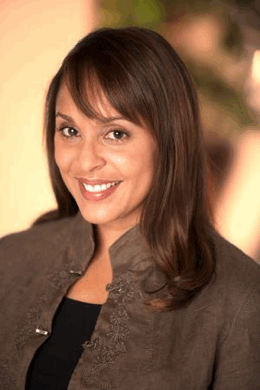
Natasha Trethewey.
YOUNG: It’s Living on Earth, I’m Jeff Young. Later this month, we’ll mark the 40th Earth Day—and April, as you may know, is also National Poetry Month. The natural world has been a favorite theme for poets over the centuries—and it still is.
TRETHEWAY: I’m Natasha Tretheway, and I began writing poems on long trips as a child. My father driving in the front seat and my stepmother beside him trying to entertain me when I got bored would say to me, ‘Why don’t you write poems about what you see outside of your window?’
And those are some of the earliest poems I began to write, and I suppose that driving through Louisiana and Mississippi what I was seeing outside of my window was the natural world speeding by. All those pine trees and the piney woods, also the swampy marshlands around New Orleans.
I think that the job of poets and poetry is to record the cultural memory of a people. And certainly our relationship to an engagement with the natural is part of that.

Natasha Trethewey.
This is “Monument”:
Today the ants are busy
beside my front steps, weaving
in and out of the hill they’re building.
I watch them emerge and—
like everything I’ve forgotten—disappear
into the subterranean, a world
made by displacement. In the cemetery
last June, I circled, lost—
weeds and grass grown up all around—
the landscape blurred and waving.
At my mother’s grave, ants streamed in
and out like arteries, a tiny hill rising
above her untended plot. Bit by bit,
red dirt piled up, spread
like a rash on the grass; I watched a long time
the ants’ determined work,
how they brought up soil
of which she will be part,
and piled it before me. Believe me when I say
I’ve tried not to begrudge them
their industry, this reminder of what
I haven’t done. Even now,
the mound is a blister on my heart,
a red and humming swarm.
I began writing this poem because I saw the ants building that ant mound outside of my apartment many years ago and it reminded me of a visit to my mother’s grave in which I’d also seen ants building a mound. One of the things that excited me about making the connection between those two things was the poems’ title.
Looking up the mound in my dictionary I learned that a mound is also a monument, and so there those ants were building the monument that I had not erected on my mother’s grave. They were tending to a kind of remembrance that I had neglected to do.
Related links:
- For more about Natasha, click here.
- Natasha's poem can be found in the book "Black Nature."
[MUSIC: “The Dolphin” from Ride The Wind (Warner Bros 1971)]
YOUNG: Natasha Tretheway is a professor of English at Emory University, where she also holds the Phyllis Wheatley Distinguished Chair in poetry.
[MUSIC: The Dolphin” from Ride The Wind (Warner Bros 1971)]
Comic Relief for Climate Change
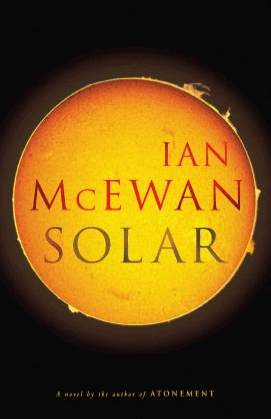
YOUNG: If Ian McEwan’s new novel, “Solar”, is any indication we can add one more item to the list of scary things about climate change. And that’s the characters we’re counting on to save the planet. Mr. McEwan’s main character, Michael Beard, is an over-the-hill, Nobel-winning physicist who has stronger convictions about wine and women than he does about global warming.
But a darkly funny incident sends Beard tumbling on a comic path to save the world with solar power. It might be the first comic novel about climate change. Ian McEwan, welcome to the program.
MCEWAN: Thank you.
YOUNG: Well, let’s start by talking about your hero here, Michael Beard.
MCEWAN: Yes, well, as you say, he’s a—his best work is behind him, he won the Nobel prize for physics back in the mid-80s for modification of Einstein’s photovoltaics, and the—it’s really a story of a man into whom I’ve poured nearly all the human weaknesses I could think of, and his attempts to work on photosynthesis—artificial photosynthesis in the New Mexican desert and bring us free energy in the form of water split into its constituent gases.
YOUNG: Which is a great idea, but not, it turns out, necessarily his idea…he’s a pretty flawed character. He’s—
MCEWAN: He is, yeah. I’m mean those of us who watched closely the COP-15, the Copenhagen conference at the end of last year, I thought it was depressing, but I also thought there was a vein of farce there. And that’s why at the very end of the novel, Michael Beard is going to, if he can, head off to address the meeting of foreign ministers at Copenhagen because he very much represents the spirit of that meeting.
YOUNG: And that’s not a compliment, that’s not compliment!
MCEWAN: No, that is certainly not a compliment. He embodies certain aspects of human nature that I think were very much alive at that conference. On the one hand, extraordinary cleverness - so science, rationality - had summed 192 nations, and then another aspect of human nature - self-interest, national self-interest, tribalism, cabals - won out.
And for that reason, everyone came home with their tails between their legs, and we have to await another round. If I can just say what this novel really is about, I guess it’s about flawed human nature trying to deal with a unique problem.
YOUNG: Now, Beard goes on this expedition to Arctic, it has artists and writers and scientists coming together to view the effects of climate change firsthand, and come up with some way to try to save the world. I understand that stems from your own personal experience—you did something very much like that?
MCEWAN: Yes, back in 2005 I went with a group of artists and scientists and we were living for a week just about on 80th parallel in the Norwegian Arctic. We had many passionate discussions in the evenings about climate change and what to do. What I noticed was the kit room, what we called the boot room, where we had to take off all our gear every time we came onto the ship so we didn’t bring ice and water into the living quarters—that boot room throughout the week was becoming more and more chaotic.
I thought there’s a huge discrepancy between the size of the boot room and the size of the earth, and the earth we want to organize when we can’t even keep this boot room straight! So that moment of the shadow falling between our aspirations and the boot room was one of the first indications I had that I thought it was at last a way into the issue of climate change.
YOUNG: Your protagonist, Mr. Beard, he’s in a fairly convoluted place, trying to make a business happen, and trying to be a sort of do-gooder. His business partner is kind of getting cold feet about the whole thing, right when they’re near the launch point for their new solar power. I’d like for you to read for us, a little excerpt from that point there where his partner, I guess, has heard from some of these climate change deniers and is starting to wonder if the whole thing is really going to work out.
MCEWAN: Toby Hammer is Michael Beard’s American partner and they’re crossing the New Mexican desert together. Toby’s a little depressed, as you say, so Michael Beard says, “ ‘Here’s the good news. The UN estimates that already a third of a million people a year are dying from climate change.

Even as we speak, Bangladesh is going down because the oceans are warming and expanding and rising. There’s drought in the Amazon rainforest. Methane is pouring out of the Siberian permafrost. There’s a meltdown under the Greenland ice sheet no one really wants to talk about. Amateur yachtsman have been sailing the northwest passage. And two years ago we lost 40 percent of the Arctic summer ice and now the eastern Antarctic is going. The future has arrived, Toby!’
‘Yeah,’ Hammer said. ‘I guess.’
‘What’s wrong with you? Trouble at home?’
‘Nothing like that,’ Hammer said. ‘Just that I put in all this work then guys in white coats come on TV to say the planet’s not heating. I get spooked.’
Beard laid a hand on his friend’s arm. A sure sign that he was getting drunk. ‘Toby, listen. It’s a catastrophe, relax.’ ”
[YOUNG LAUGHS]
YOUNG: It’s a catastrophe, relax! Is that the point that we’ve reached though? Where business people are seeing the great opportunity in the catastrophe?
MCEWAN: There are some very dodgy outfits out there, I mean, especially in Europe where the subsidy business for renewable energies has been up and running for a while, so various scams are coming to light. The European Union is centralized in Brussels, handing out money to people down in Spain and Italy who are claiming they’ve got wind farms that don’t exist! So we have to be very careful.
YOUNG: I felt that one of the challenges underneath what I was reading in your book was, we can’t depend on being virtuous or being moral to address this problem. That we have to deal with people like Michael Beard.
MCEWAN: I think what we’re looking at and what we need is basically an industrial revolution. It was brilliant to—and clever of us to—think of ways of replacing human labor by burning these fossil fuels. They’ve now caused us a new problem and we’re going to have to use our ingenuity to get out of this.
And any great industrial change is going to bring all kinds of people. It’s going to be like the Wild West—frontier towns are going to be brimming with unsavory types packing six-shooters. It doesn’t matter as long as there’s a general, overall regulatory framework for safety and much else. I think we can expect that ambition, invention, greed will all pile in there. And I think it’s great that people use the bottle bank and recycle their waste and get a smaller car, and so on. But as Michael Beard says in one of his lectures at the Savoy hotel in London. That will slow our use of fossil fuels, but actually we’ve got to replace them—have a revolution in the way we power our lives.
YOUNG: Yeah, he’s speaking to some I guess potential investors, and he says, “ ‘Virtue is too passive, too narrow. Virtue can motivate individuals, but for groups, society as a whole, civilization it’s a weak force. For humanity, greed trumps virtue.’ ” Now, is that just Beard speaking there, or is that you?
MCEWAN: No, I’m—I can hide behind Beard at this point. I get him to say all kinds of unsavory things that I’d would sort of quarter believe in and not really want to defend. This is what I do believe: that actually nations do not often act virtuously. Individuals do.
YOUNG: Beard was not an easy guy to stick with through the book. I mean, I laughed a lot, but he’s such a foul person, I kept waiting for the moment where he’s going to see the light in this book named “Solar” and he’s going to change, and that’s going to be the lesson at the end. And I got to the end of the book and he didn’t change. Is that what you believe that people don’t really change that much?
MCEWAN: No, I don’t think people really change. I mean, I think most of us much like we are at the age of two, we get to know more, but I don’t think people really change. I know it’s deep in the American creed that you can remake yourself, but I come from the Old World and I think that people are what they are. Michael Beard is a sort of chaotic figure and I have to say that it gave me no pleasure, but I felt vindicated in what I’d made of him by the end of the Copenhagen conference.
YOUNG: At some point during I guess when you were just finishing up this book the whole so-called Climategate episode burst into public—
MCEWAN: Yeah…
YOUNG: These hacked emails from the University of East Anglia. Is that where you went to school? Is that right?
MCEWAN: Yes, I was there as a graduate student in 1970. The so-called Climategate matter just seems to me an extraordinary example of how the denialist lobby can fix on a couple of emails and turn it into an issue that has caused public trust in climate science to plummet. But also science is messy and human, and climate science and the biosphere are both young objects of study and fantastically complex.
Maybe what lies behind this fuss was a rather naïve assumption in the public’s mind that science was a sort of lordly, clinical, passionless enterprise, and for that reason emails like this become shocking. But anyone who’s sat in a senior common room or listened to scientists gossip about each other knows that it’s just as flawed as everything else. The project of science, itself is always bigger than the individuals who are doing it.
YOUNG: You know, we don’t get many novels about climate change. We get a lot of books about climate change, but to my knowledge, this is the first novel and certainly the first comic novel that I’ve read on this topic. Would you do it again? What did you think of this area as a setting for a novel?
MCEWAN: Well, I think so. I mean the problem is too extensive and I think the human ramifications are so extensive. This is one of those literally global issues that penetrates private lives. So I mean either it will come from me or it’ll come from—there are plenty of us novelists around. But one way or another it will force its way into the novel. This subject will not go away, it will shape human destinies and novels are bound to reflect that.
YOUNG: Ian McEwan, the novel is “Solar”. Thank you very much.
MCEWAN: My pleasure.
Related link:
For more on Ian McEwan’s book, click here.
[MUSIC: Hot Tuna “Belly Shadow” from Hot Tuna (BMG Reissue 1996)]
Woodcock Courtship
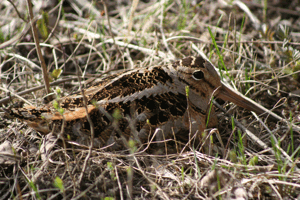
(Photo: guizmo_68)
YOUNG: Spring is here. And for one small and usually shy bird, love is, literally, in the air. This time every year, the male American woodcock descends on a grassy spot called a "singing field" and begins a unique courting display. Bob Speare, a naturalist with the Massachusetts Audubon Society, has been watching this show for years and invited us to join him one evening at the Society sanctuary in Ipswich.
[SOUND OF WALKING, BIRDS AND INSECT]

(Photo: tokara)
SPEARE: Oh, this is going to be a good night. I can feel it. We can hang out right here until it comes in. A woodcock is kind of a really silly looking bird. It's a short, stout bird that has a very long bill that it uses to probe into the ground to search for earthworms. It has short, rounded wings. It does have eyes set way back on the top of its head. And it allows the bird to see almost 360 degrees to see what's going on around it.
[BIRD SOUNDS]
SPEARE: As we're getting closer to the time that the woodcocks come out, we're starting to see some of these day birds and other animals kind of punching out for the day and going home. Once we reach the right candle power of light, we'll probably first hear one of these animals come in. Their wings give a little twittering sound [he imitates twittering sound] as they fly in to that specific spot on the ground. And once they do, they'll almost immediately begin with this nasally peent, peent, peent.
[WOODCOCK PEENT]
SPEARE: There it is!
[WOODCOCK PEENT]
SPEARE: And then they'll burst into the air. And again, you'll hear that little [he imitates twittering sound] of the wings as they spiral up several hundred feet, or a couple of hundred feet anyway.
[SOUND OF WOODCOCK WING TWITTERING]
SPEARE: There he goes. There he goes. He's in the air. There he goes. Now he's descending. He's kind of free falling back down, heading back to the same spot. Here he comes. Bang. He's back on the ground.
[WOODCOCK PEENT]
SPEARE: Exact same spot. Exact same place. There's a quality in that display, that the female is probably gauging in her head to realize, ‘Is this the one for me?’ It's pretty amazing to think that they'll come out in any kind of weather, and just keep going night after night after night, even though nobody's interested. It's very seldom that they actually attract a mate. Yet, they're out there every single night, doing it over and over and over.
YOUNG: Naturalist Bob Speare, watching the woodcocks at the Massachusetts Audubon Society Sanctuary in Ipswich.
[MUSIC: Carolina Chocolate Drops “Peace Behind The Bridge” from Genuine Negro Jig (Nonesuch Records 2009)]
YOUNG: On the next Living on Earth—what the man who founded Earth Day was hoping to create.
NELSON: An environment without ugliness, without ghettos, without poverty, without discrimination, without hunger, and without war. Our goal is a decent environment in its broadest and deepest sense.
YOUNG: Gaylord Nelson on Earth Day’s 40th birthday—next time on Living on Earth.
[MUSIC: Carolina Chocolate Drops “Peace Behind The Bridge” from Genuine Negro Jig (Nonesuch Records 2009)]
YOUNG: Living on Earth is produced by the World Media Foundation. Our crew includes Bobby Bascomb, Eileen Bolinsky, Bruce Gellerman, Ingrid Lobet, Helen Palmer, Jessica Ilyse Smith, Ike Sriskandarajah, and Mitra Taj, with help from Sarah Calkins, Marilyn Govoni and Sammy Sousa. Our interns are Emily Guerin and Bridget Macdonald. Engineering help this week from Dana Chisholm. Jeff Turton is our technical director. Alison Lirish Dean composed our themes. Steve Curwood is our Executive Producer. You can find us anytime at l-o-e dot org. I’m Jeff Young. Thanks for listening.
ANNOUNCER: Funding for Living on Earth comes from the National Science Foundation, supporting coverage of emerging science. And Stonyfield Farm, organic yogurt and smoothies. Stonyfield pays its farmers not to use artificial growth hormones on their cows. Details at Stonyfield dot com. Support also comes from you our listeners, The Ford Foundation, The Town Creek Foundation, The Oak Foundation, supporting coverage of climate change and marine issues. And Pax World Mutual Funds, integrating environmental, social and governance factors into investment analysis and decision making, on the Web at Pax World dot com. Pax World – for tomorrow.
Living on Earth wants to hear from you!
Living on Earth
62 Calef Highway, Suite 212
Lee, NH 03861
Telephone: 617-287-4121
E-mail: comments@loe.org
Newsletter [Click here]
Donate to Living on Earth!
Living on Earth is an independent media program and relies entirely on contributions from listeners and institutions supporting public service. Please donate now to preserve an independent environmental voice.
NewsletterLiving on Earth offers a weekly delivery of the show's rundown to your mailbox. Sign up for our newsletter today!
 Sailors For The Sea: Be the change you want to sea.
Sailors For The Sea: Be the change you want to sea.
 The Grantham Foundation for the Protection of the Environment: Committed to protecting and improving the health of the global environment.
The Grantham Foundation for the Protection of the Environment: Committed to protecting and improving the health of the global environment.
 Contribute to Living on Earth and receive, as our gift to you, an archival print of one of Mark Seth Lender's extraordinary wildlife photographs. Follow the link to see Mark's current collection of photographs.
Contribute to Living on Earth and receive, as our gift to you, an archival print of one of Mark Seth Lender's extraordinary wildlife photographs. Follow the link to see Mark's current collection of photographs.
 Buy a signed copy of Mark Seth Lender's book Smeagull the Seagull & support Living on Earth
Buy a signed copy of Mark Seth Lender's book Smeagull the Seagull & support Living on Earth

